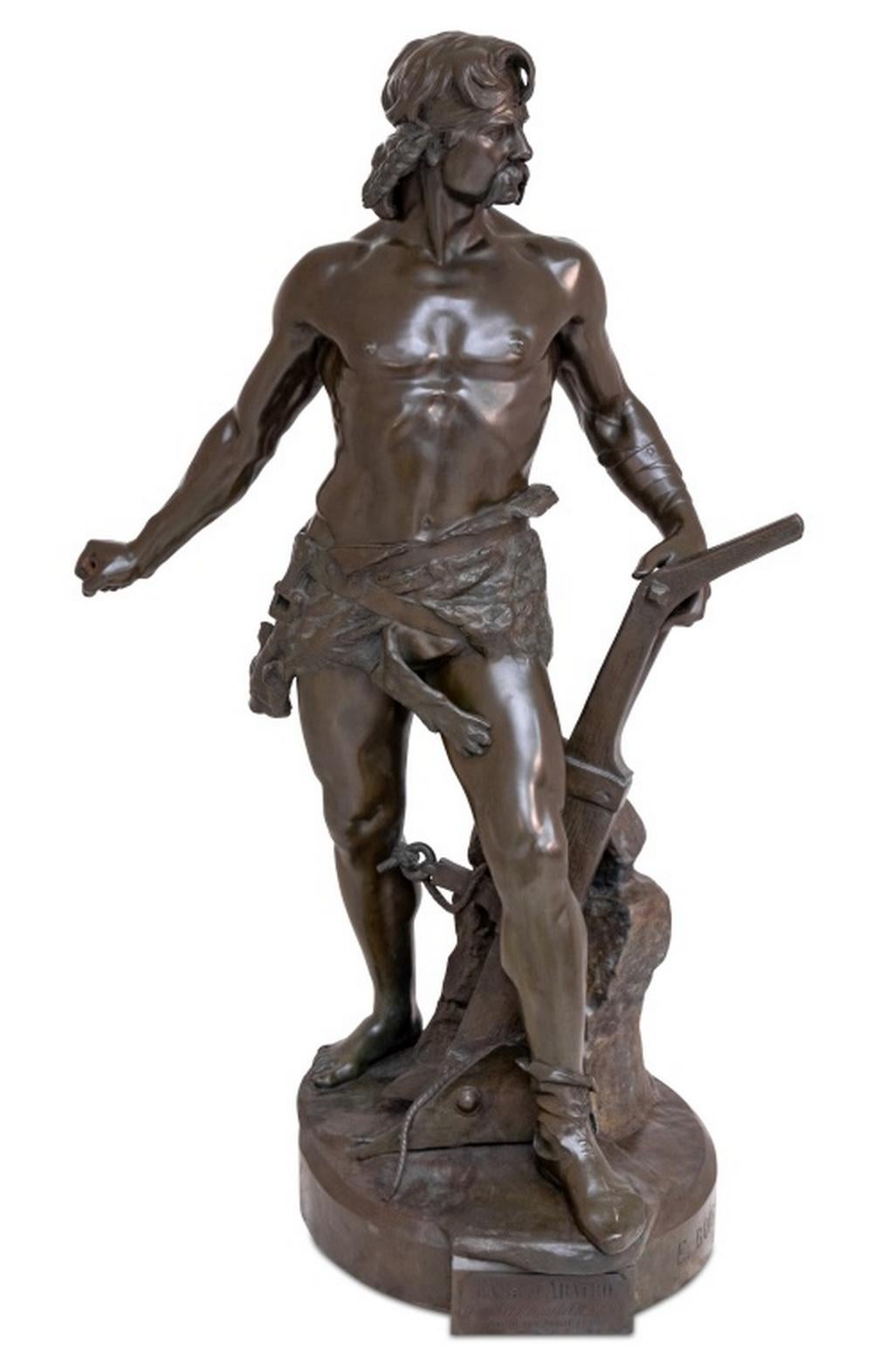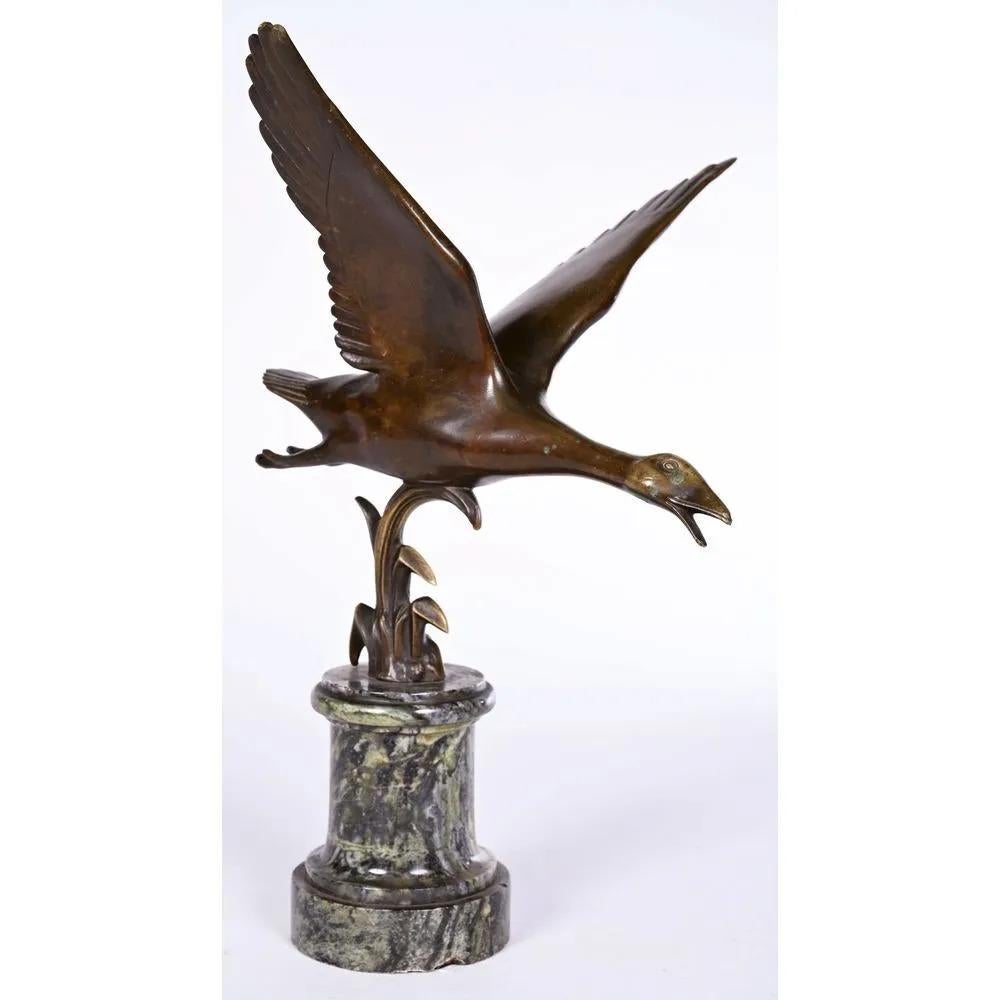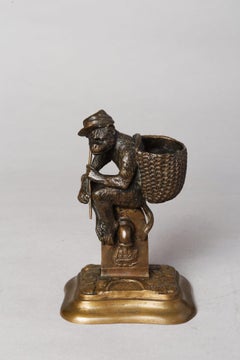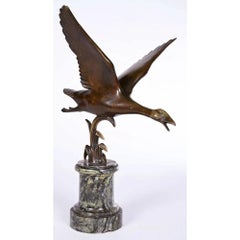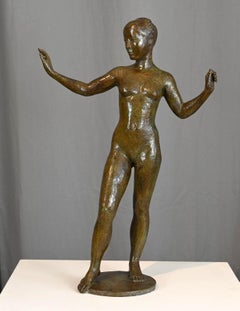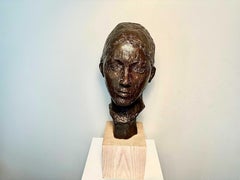Artículos similares a Centaur abducting a woman
¿Quieres más imágenes o vídeos?
Solicita imágenes o vídeos adicionales al vendedor
1 de 15
Aimé-Jules DalouCentaur abducting a womancirca 1895-1902
circa 1895-1902
Acerca del artículo
Centaur abducting a woman
by Aimé-Jules DALOU (1838-1902)
A bronze group sculpture with a dark brown patina
Signed on the base "Dalou"
Cast by "A.A. Hébrard" (with the foundry stamp)
The casts by Hébrard are always the finest ones regarding Dalou's works. Perfect in quality of cast and patina.
France
posthumous cast around 1910
height 27 cm
width 21 cm
depth 15,5 cm
A similar model reproduced in "Jules Dalou, le sculpteur de la République", Exhibition held at the Musée du Petit Palais, Paris, 2013, page 415, n°337.
Biography :
Aimé-Jules Dalou, said Jules Dalou (1838-1902) was a French sculptor, born from Protestants glovers craftsmen who raised in secularism and love of the Republic. Jules Dalou was very young talented for modeling and drawing, which earned him the attention of Jean-Baptiste Carpeaux, who made him entered in 1852 in the Little School, the future National School of Decorative Arts in Paris. In 1854, he was admitted to the School of Fine Arts in Paris, where he studied painting in the workshop of Abel de Pujol and sculpture in the workshop of Francisque Duret. He began to earn his living by working for decorators, and began his friendship with Auguste Rodin. Dalou then produced decorative sculptures for buildings on major Parisian avenues, such as the Hotel de la Paiva, on the Champs-Elysees Avenue. He presented but failed four times to Rome prize competition, but exhibited at the 1869 Salon his "Daphnis and Chloe" and the "Embroiderer" at the Salon of 1870, two pieces acquired by the French state. Dalou had one child, Georgette, a girl born with a mental handicap. This is to ensure funding for her daughter's life accommodation in the Orphanage of Arts, that Dalou bequeathed the funds from his workshop to this institution.
After the bloody week of May 1871 Dalou, his wife and their daughter were threatened as Communards, forced into exile and requested asylum. They then joined England and were greeted by his former fellows of the Little School, the painter Alphonse Legros. With Legros, much introduced in the City, he made a serie of terracotta statuettes inspired by boulonnaise peasants or intimate subjects (readers, lullabies), and portraits of the English aristocracy. He became professor for modeling at the National Art Training School, his influence was decisive for many British sculptors. He received orders for a public fountain in marble titled "Charity" (1877) near the Royal Exchange in London, and a monument dedicated to Queen Victoria's grandchildren located in the private chapel of Frogmore at Windsor Castle.
In May 1874, the Paris War Council condemned Dalou in absentia to hard labor for life. Having refused to beg for mercy, he was only in May 1879 being granted amnesty and his family finally returned from exile. His group "The Triumph of the Republic", originally planned for the Place de la Republique in Paris, was finally erected on the Place du Trône, renamed Place de La Nation in 1880. Dalou devoted twenty years to the realization of this monument. The years 1881 and 1882 were difficult, but the 1883 Salon finally revealed him to the French public. He exhibited his two high reliefs: "The Brotherhood of Peoples" and "Mirabeau answering Dreux-Brézé", for which he was awarded the Medal of Honor. Fleeing the world and living in family, Dalou engaged in considerable work and many orders both private and public. For the Universal Exhibition of 1889, was inaugurated on the Place de la Nation the plaster of "The Triumph of the Republic" commissioned by the city of Paris in 1879. Although the bronze version of the group was inaugurated in 1899, this work won the grand prize for sculpture in the exhibition. Dalou left the French Society of Artists in 1890 to expose at the National Society of Fine Arts, of which he was a founding member with Ernest Meissonier, Auguste Rodin and Pierre Puvis de Chavannes. Awarded Knight of the Legion of Honor in 1883, and promoted to officer by President Carnot in 1889, he was elevated to the rank of Commander of the same order in 1899 by President Loubet at the inauguration of the monument of "The Triumph of the Republic".
Dalou had no time to complete his last great project, a monument dedicated to workers, the idea came to him in 1889 after the first opening of "TheTriumph of the Republic". The formality of the ceremony and military parades held the people away from the official event. Dalou was disappointed. True to its republican ideals, he had hoped that this inauguration was an opportunity of great popular democratic party (as it was at the inauguration of the bronze in 1899). His idea was then to pay tribute to the world of workers, craftsmen and peasants with this work being the central subject. At the end of his career Dalou described the project as follows: "I think I have finally found the monument to the workers that I seek since 1889. Sober, without molding or ornament, I wish it'd be severe and imposing. Will I execute it? There is the question. I am old and my health is so weak."
- Creador:Aimé-Jules Dalou (1838 - 1902, Francés)
- Año de creación:circa 1895-1902
- Dimensiones:Altura: 27 cm (10,63 in)Anchura: 21 cm (8,27 in)Profundidad: 15,5 cm (6,11 in)
- Medio:
- Movimiento y estilo:
- Época:
- Estado:
- Ubicación de la galería:PARIS, FR
- Número de referencia:Vendedor: N.X1stDibs: LU2514216390642
Sobre el vendedor
5,0
Vendedor reconocido
Estos prestigiosos vendedores son líderes del sector y representan el escalón más alto en cuanto a calidad y diseño de artículos.
Establecido en 1992
Vendedor de 1stDibs desde 2023
7 ventas en 1stDibs
Tiempo de respuesta usual: 14 horas
- EnvíoRecuperando presupuesto…Envío desde: PARIS, Francia
- Política de devolución
Partes de esta página se han traducido automáticamente. 1stDibs no puede garantizar la exactitud de las traducciones. El inglés es el idioma predeterminado de este sitio web.
Garantía de autenticidad
En el improbable caso de que haya algún problema con la autenticidad de un artículo, ponte en contacto con nosotros en un plazo de 1 año para recibir un reembolso total. DetallesGarantía de devolución de dinero
Si tu artículo no es como se describe, sufre daños durante el transporte o no llega, ponte en contacto con nosotros en un plazo de 7 días para recibir un reembolso total. DetallesCancelación dentro de las 24 horas
Tienes un período de gracia de 24 horas para reconsiderar tu compra, sin preguntas.Vendedores profesionales aprobados
Nuestros vendedores de primera clase deben cumplir estrictos estándares de servicio para mantener la integridad de nuestros anuncios.Garantía de igualación de precios
Si encuentras que un vendedor publicó el mismo artículo por un precio menor en otro lado, igualaremos ese precio.Entrega global de confianza
Nuestra red de transporte de primera ofrece opciones de envío especializado en todo el mundo, que incluye envío personalizado.Más de este vendedor
Ver todoPortafósforos Mono
Por Christophe Fratin
Portafósforos Mono
por Christophe FRATIN (1801-1864)
Bronce con pátina marrón matizada
Firmado en la base "Fratin"
Reparto edición antigua
Francia
hacia 1850
altura 14,5 cm
anchur...
Categoría
Mediados del siglo XIX, Escuela francesa, Esculturas figurativas
Materiales
Bronce
Mujer joven sentada con cortinas
Mujer joven sentada con cortinas
de Pierre Marie POISSON (1876-1953)
Escultura de bronce con pátina verde matizada
firmado en la base "P. Poisson".
antiguo reparto
Francia
hacia 1...
Categoría
Década de 1930, Escuela francesa, Esculturas de desnudos
Materiales
Bronce
Las Tres Gracias
Las Tres Gracias
por Alfred JANNIOT (1889-1969)
Un grupo de bronce con una pátina verde pardusca matizada
Firmado en el lateral de la base "A. Janniot"
Fundido por "Susse fondeur Pa...
Categoría
mediados del siglo XX, Escuela francesa, Esculturas figurativas
Materiales
Bronce
34.785 US$
Maternidad
Por Baltasar Lobo
Maternidad
por Baltasar LOBO (1910-1993)
Un grupo de bronce con pátina verde pardusca
Firmado en la parte inferior delantera " Lobo ".
Fundido por " Susse Fondeur Paris " (con la ma...
Categoría
mediados del siglo XX, Escuela francesa, Esculturas figurativas
Materiales
Bronce
55.656 US$
Gorila secuestrando a una mujer
Por Emmanuel Fremiet
Emmanuel FREMIET (1824-1910)
Gorila secuestrando a una mujer
Un raro grupo de bronce con pátina marrón oscura verdosa
firmada "E. Fremiet" en la base
fundido por " F. Barbedienne F...
Categoría
Fines del siglo XIX, Escuela francesa, Esculturas figurativas
Materiales
Bronce
Ciervo andante N.2
Por Antoine-Louis Barye
Ciervo andante N.2
de Antoine-Louis BARYE (1796-1875)
Bronce con pátina marrón verdosa oscura
firmado en la base "Barye
molde antiguo probablemente de Brame
Francia
hacia 1880
alt...
Categoría
Década de 1880, Escuela francesa, Esculturas figurativas
Materiales
Bronce
También te puede gustar
Emile Boisseau "Ense et Aratro" Bronce patinado para Tiffany & Co.
Emile Andre Boisseau (francés, 1842-1923) Escultura de bronce patinado "Ense et Aratro" [Con la espada o con el arado], vendida por Tiffany & Co. a finales del siglo XIX; el guerrero...
Categoría
Fines del siglo XIX, Escuela francesa, Esculturas figurativas
Materiales
Bronce
Bronce Art Déco Représentant Une Oie, Les Ailes Déployées
Bronce Art Déco representando una oie, las ailes desplegadas. Il est à fine patine brune. Socle en marbre vert. Signé de LUC. H.31 L.21.
Categoría
Década de 1920, Escuela francesa, Esculturas figurativas
Materiales
Bronce
Marie
Jacques COQUILLAY (nacido en 1935)
Marie
Bronce original
Tamaño : 56x39x17cm
Ejemplar nº 4/8
Firma y numeración en la base.
Bronce original hecho a la "cera perdida
La edición de ...
Categoría
Principios de los 2000, Escuela francesa, Esculturas de desnudos
Materiales
Bronce
9276 US$
Mujer desconocida
Inspirada en la cabeza de Apolo de Antoine Bourdelle. Una mujer con una expresión fuerte y firme, pero a la vez vulnerable.
Categoría
Década de 1980, Escuela francesa, Esculturas figurativas
Materiales
Bronce
4232 US$
"Le Chanteur Florentin"
Por Paul Dubois
Según Paul Dubois (francés, 1829-1905) "Le Chanteur Florentin" [El Cantante Florentino] Escultura de bronce patinado, el cantante de pie descansa sobre un pedestal mientras toca un l...
Categoría
Fines del siglo XIX, Escuela francesa, Esculturas figurativas
Materiales
Bronce
Antique French Polish Bronce Dorado Estatua Escultura Figura Espadachín 1890
Fina escultura antigua francesa de bronce dorado de un espadachín, obra del artista y escultor franco-polaco Henryk II Kossowski (1855-1921), el bronce data de 1890.
El bronce repres...
Categoría
Década de 1890, Escuela francesa, Esculturas figurativas
Materiales
Alabastro, Bronce
